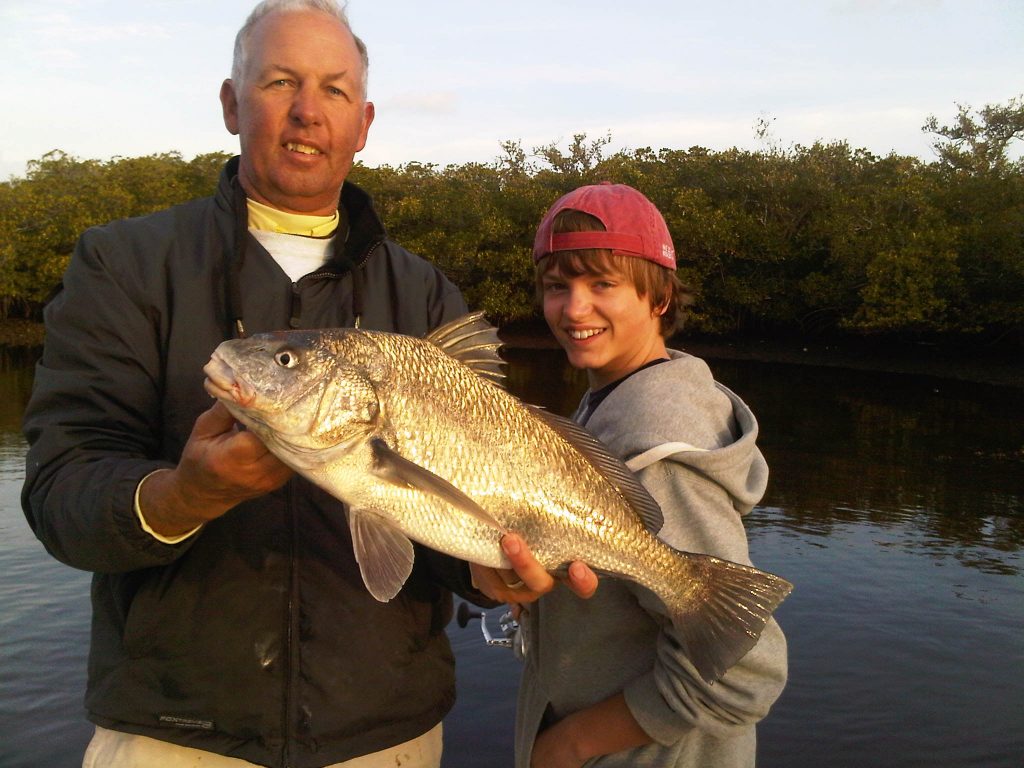Black Drum Fishing – A Complete Guide
This article will cover black drum fishing. These cousins to red drum, or redfish, are a popular inshore saltwater species.
Black drum, Pogonias cromis, are found along the coastal water of the United States from Texas to the Mid Atlantic. They grow large, with the world record being 113 pounds. Black drum feed primarily on crustaceans. Smaller drum are excellent to eat, while larger specimens tend to have worms.
Black drum fishing
Black drum are found from New England along the coast to Texas and into Mexico. However, they are most commonly caught from the mid Atlantic states around to Texas. Juvenile and smaller black drum will inhabit brackish estuary systems while larger mature black drum are mostly found in the saltier, open waters of the Gulf of Mexico and Atlantic Ocean. Large bays will hold schools of big black drum as well.
One look at the mouth of a black drum will let an angler know how it feeds. They feed almost exclusively on crustaceans, which live on or near the bottom. Black drum have an “inferior” mouth, which means it is behind the nose. Drum also have crushers in their throat which allows them to feed on anything with a shell.
Black drum feed at night
Black drum are nocturnal and most definitely feed at night. Lighted bridges, especially in passes and inlets on the outgoing tide are prime spots. Anglers fishing from piers catch them as well. Shallow bars will hold fish, but navigating in the dark can be tricky and is best left to experienced anglers.
Black drum vs sheepshead
Black drum do look quite a bit like sheepshead. The two also feed on similar prey and inhabit the same waters. However, when held side by side, it is fairly easy to distinguish the two. Black drum are cousins to the red drum, or redfish. They are also similar in looks and habits to sheepshead. In fact, smaller black drum can be mistaken for sheepshead. Black drum are wider and have barbels under the chin. Both feed on crustaceans near structure. Black drum can be found in very shallow water as well as in quite deep holes. They are usually located in schools and often relate to structure of some type. Bridges, docks, oyster bars, jetties, rocks, and hard bottom areas will hold fish.
Black drum are great to eat
Black drum are very good to eat. Most fish that feed on crustaceans are desirable, and black drum are no exception. However, this really only applies to smaller fish. Most anglers find black drum between 14” and 24” to be the best to keep. Larger drum tend to be wormy and the breeder fish are best released to ensure good populations of fish.
Best baits for black drum fishing
As mentioned above, black drum feed primarily on crustaceans. Crabs of all types are top black drum fishing baits. Blue crabs are cut in halves or quarters while smaller crabs are fished whole. Shrimp are also a preferred forage of black drum, as they are for most saltwater species. Both crabs and shrimp work well both live and dead as the scent is a major component in attracting fish.
While black drum can be taken by anglers using artificial lures, the vast majority of fish are taken on natural or live baits. The few black drum that are fooled by lures will hit a soft plastic bait bounced slowly along the bottom. Spoons will catch a few fish as well.
Best black drum fishing tackle
A 7′ medium action rod with a 3000-4000 series reel spooled up with 20 lb braided line is an excellent all round combination. It will allow anglers to cast light baits to drum in shallow water while providing enough backbone to handle a decent fish.
Click links to shop Amazon for Penn spinning and conventional outfits
Anglers fishing for large black drum around structure such as bridges, docks, jetties, and in rock holes will need to beef up the tackle. In these application, conventional tackle is usually the best choice. No casting is required and anglers can muscle up on a large fish.
“Fishing Lido Key is a participant in the Amazon Associates Program, an affiliate advertising program designed to provide a means for sites to earn advertising fees by advertising and linking to Amazon. As an Amazon Associate I earn from qualifying purchases. ”
Best black drum fishing rigs
Rigging for black drum is fairly uncomplicated. In shallow water, a simple rig consisting of a 24” to 30” piece of 25 lb to 40 lb flourocarbon leader and a 2/0 to 5/0 circle hook is all that is required. A small split shot or even a small sliding egg sinker can be added is the current is strong. It is best for the bait to sit in one spot.
In deeper water, the traditional Carolina rig is a good all around choice. It presents the bait on the bottom while allowing for easy weight changes as conditions change. This rig also works well for anglers surf fishing for black drum as well.
Black drum fishing techniques
If there is one single tip that will help anglers fishing for black drum, it is to keep the bait still and on the bottom. This applies to anglers fishing in both shallow water and in deep water. Black drum roam about quite a bit in search of food. The scent of the bait will attract black drum.
It is best to fish for black drum during periods of good current flow. This will help the scent disperse through the water and attract black drum and other species to the bait. Many anglers prefer a high, outgoing tide as it will stage fish on the edges of flats.
Black drum can be difficult to hook, even large fish. They tend to “mouth” the bait and the take can be subtle. The best technique is to wait out the “taps” until a steady pull or weight is felt. Anglers should then reel fast and come tight. Circle hooks have become quite popular. They work well and drastically reduce fish mortality as most fish are hooked in the mouth.
Fishing docks and bridges for black drum
Bridges and docks are top spots for anglers to find black drum, They provide structure, shade, forage, and are often located in areas of high current flow. These elements combine to make docks and bridges prime black drum fishing spots. Many also offer anglers without a boat access to some good fishing.
In most cases, the best approach when fishing for black drum around docks and bridges is to fish the up-tide side of the structure. This is true for anglers in boats as well as fishing from the dock or bridge. The bait can then drift back naturally to the structure. Night fishing can be extremely productive. Anglers fishing for big drum, especially in strong currents, will need fairly stout tackle to handle a big fish.
Night fishing for black drum
Black drum are definitely nocturnal feeders. They use their sense of smell more that sight, so feeding in the dark is not an issue. This is mostly done near lighted bridges, docks, inlets and off the beach. Surf fishing at night for black drum can be very productive.
Passes and inlets are prime black drum fishing spots
Passes and inlets are natural fishing spots for black drum and many other species. They are passages that connect the open Gulf and ocean with the inshore bays. Fish will move through and stop to feed. Current flow, structure, and forage combine to make passes and inlets terrific fishing spots.
Anglers fishing passes and inlets really need to pay attention to the tides. Fishing can be very difficult, and even dangerous, when the current is running hard. It will take a lot of weight to hit and hold the bottom. Therefore, the periods just before and after the tide change are usually the best times to fish these areas, as are days with weaker tides.
Black drum fishing tidal creeks and oyster bars
Black drum love oyster bars and tidal creeks. The reason is simple; food, and a lot of it! Oysters are home to a variety of crustaceans that black drum feed on. Drum will cruise the bars in search of food. Many anglers prefer the lower tide stages as that tends to concentrate fish on the edges. On a flood tide, drum will move up on top of the bars and scatter out. While they feed at this time, they are more difficult to locate.
For the most part, the best rig is a bait fishing on the bottom with little or no weight. This will present the bait naturally while reducing snags. Another effective approach is to fish a bait on a jig head. A jig head combines the hook and weight in a tidy unit that is easy to cast. This works especially well with a live shrimp.
Fish can be spooky in this shallow water. Successful anglers take care to be as quiet as possible and keep their offering as natural looking as possible. Anglers will often see the fish “waking” and “tailing” in the shallow water, similar to redfish. Most of these fish will be in the 5-20 pound range, so spinning tackle is usually the best choice. The mouths of little feeder creeks and cuts are terrific spots on the falling tide.
River mouths offer excellent black drum fishing
River mouths are top spots to fishing black drum. This is true for the smallest creeks up to larger rivers in huge estuary systems. Chesapeake Bay is a great example of this, many large rivers empty into the bay and black drum will school up in deeper holes. The combination of current flow and structure makes these areas productive spots.
Surf fishing for black drum
Black drum are a highly sought after species for anglers surf fishing. They are perhaps the largest fish a surf fishing angler will encounter, other than sharks. Heavy surf fishing tackle is used to heavy large baits out over the breaking waves. Black drum will also be found right in the “wash” close to shore, especially after a storm moves through stirring up the bottom.
Crabs are the top bait for anglers surf fishing for black drum. A fish finder rig works well with enough weight to hold bottom. Two hours before and after high tide is a great time to fish. Shrimp can be used,m especially for smaller fish. Black drum will also take cut bait meant for other species.
In conclusion, this article on black drum fishing will help anglers catch more of these tasty and hard fighting bottom species.







